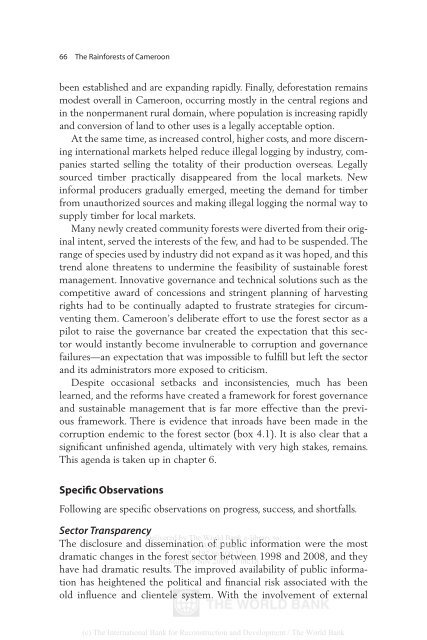The Rainforests of Cameroon - PROFOR
The Rainforests of Cameroon - PROFOR
The Rainforests of Cameroon - PROFOR
- No tags were found...
Create successful ePaper yourself
Turn your PDF publications into a flip-book with our unique Google optimized e-Paper software.
66 <strong>The</strong> <strong>Rainforests</strong> <strong>of</strong> <strong>Cameroon</strong>been established and are expanding rapidly. Finally, deforestation remainsmodest overall in <strong>Cameroon</strong>, occurring mostly in the central regions andin the nonpermanent rural domain, where population is increasing rapidlyand conversion <strong>of</strong> land to other uses is a legally acceptable option.At the same time, as increased control, higher costs, and more discerninginternational markets helped reduce illegal logging by industry, companiesstarted selling the totality <strong>of</strong> their production overseas. Legallysourced timber practically disappeared from the local markets. Newinformal producers gradually emerged, meeting the demand for timberfrom unauthorized sources and making illegal logging the normal way tosupply timber for local markets.Many newly created community forests were diverted from their originalintent, served the interests <strong>of</strong> the few, and had to be suspended. <strong>The</strong>range <strong>of</strong> species used by industry did not expand as it was hoped, and thistrend alone threatens to undermine the feasibility <strong>of</strong> sustainable forestmanagement. Innovative governance and technical solutions such as thecompetitive award <strong>of</strong> concessions and stringent planning <strong>of</strong> harvestingrights had to be continually adapted to frustrate strategies for circumventingthem. <strong>Cameroon</strong>’s deliberate effort to use the forest sector as apilot to raise the governance bar created the expectation that this sectorwould instantly become invulnerable to corruption and governancefailures—an expectation that was impossible to fulfill but left the sectorand its administrators more exposed to criticism.Despite occasional setbacks and inconsistencies, much has beenlearned, and the reforms have created a framework for forest governanceand sustainable management that is far more effective than the previousframework. <strong>The</strong>re is evidence that inroads have been made in thecorruption endemic to the forest sector (box 4.1). It is also clear that asignificant unfinished agenda, ultimately with very high stakes, remains.This agenda is taken up in chapter 6.Specific ObservationsFollowing are specific observations on progress, success, and shortfalls.Sector TransparencyDelivered by <strong>The</strong> World Bank e-library to:<strong>The</strong> disclosure and dissemination <strong>The</strong> World <strong>of</strong> public Bank information were the mostdramatic changes in the forest IP sector : 192.86.100.34 between 1998 and 2008, and theyMon, 09 Nov 2009 17:06:18have had dramatic results. <strong>The</strong> improved availability <strong>of</strong> public informationhas heightened the political and financial risk associated with theold influence and clientele system. With the involvement <strong>of</strong> external(c) <strong>The</strong> International Bank for Reconstruction and Development / <strong>The</strong> World Bank
















